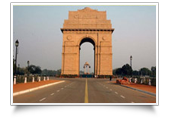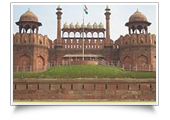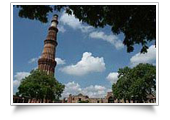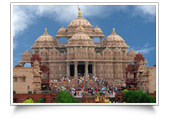|
|
|
|
 |
 |
|
New Delhi |
 |
|
|
|
Delhi is the capital of India since old times. Delhi's history dates back to the first millenium BC, when it was known as indraprastha. The Tomar Rajputs built Lal Kot, the core of the first of Delhi's seven cities. It is the epicenter of the nation's politics, economy and culture. History is alive and throbbing in Delhi, the capital of India. It is often said that the history of India is the history of Delhi. New Delhi, the capital of India, has always occupied a strategic position in the country's history, as Hindu and Islamic dynasties have ruled from here, leaving their imprint in the form of relics, which recapture those bygone times. Delhi, is today, one of the fastest growing cities of India. |
|
| FAMOUS Places IN Delhi |
|
| INDIA GATE |
 The India Gate is the national monument of India. Situated in the heart of New Delhi, India Gate was designed by Sir Edwin Lutyens. Originally known as All India War Memorial, it is a prominent landmark in Delhi and commemorates the 90,000 soldiers of the British Indian Army who lost their lives while fighting for the British Indian Empire, or more correctly the British Raj in World War I and the Third Anglo-Afghan War. The India Gate is the national monument of India. Situated in the heart of New Delhi, India Gate was designed by Sir Edwin Lutyens. Originally known as All India War Memorial, it is a prominent landmark in Delhi and commemorates the 90,000 soldiers of the British Indian Army who lost their lives while fighting for the British Indian Empire, or more correctly the British Raj in World War I and the Third Anglo-Afghan War.
It is composed of red sand stone and granite. Following India's independence, India Gate became the site of the Indian Army's Tomb of the Unknown Soldier, known as the n Jyoti(The flame of the immortal soldier). |
|
| RED FORT |
 The Red Fort was the palace for Mughal Emperor Shah Jahan's new capital, Shahjahanabad, the seventh city in the Delhi site. He moved his capital here from Agra in a move designed to bring prestige to his reign, and to provide ample opportunity to apply his ambitious building schemes and interests. The fort lies along the Yamuna River, which fed the moats that surround most of the wall. The wall at its north-eastern corner is adjacent to an older fort, the Salimgarh Fort, a defence built by Islam Shah Suri in 1546.The construction of the Red Fort began in 1638 and was completed by 1648.
The Red Fort was the palace for Mughal Emperor Shah Jahan's new capital, Shahjahanabad, the seventh city in the Delhi site. He moved his capital here from Agra in a move designed to bring prestige to his reign, and to provide ample opportunity to apply his ambitious building schemes and interests. The fort lies along the Yamuna River, which fed the moats that surround most of the wall. The wall at its north-eastern corner is adjacent to an older fort, the Salimgarh Fort, a defence built by Islam Shah Suri in 1546.The construction of the Red Fort began in 1638 and was completed by 1648. |
|
| QUTUB MINAR |
 The Qutub Minar is a tower located in Delhi,India. It is the world's tallest brick minaret with a height of 72.5 meters (237.8 ft). Construction commenced by Qutb-ud-din Aibak who won Delhi from the Prithviraj under Muhammad Ghori as his commander in chief, and finished by Iltutmish, The Qutub Minar is notable for being one of the earliest and most prominent examples of Indo-Islamic architecture. It is surrounded by several other ancient and medieval structures and ruins, collectively known as Qutub complex.Qutab Minar is the nearest station on the Delhi Metro. The Qutub Minar is a tower located in Delhi,India. It is the world's tallest brick minaret with a height of 72.5 meters (237.8 ft). Construction commenced by Qutb-ud-din Aibak who won Delhi from the Prithviraj under Muhammad Ghori as his commander in chief, and finished by Iltutmish, The Qutub Minar is notable for being one of the earliest and most prominent examples of Indo-Islamic architecture. It is surrounded by several other ancient and medieval structures and ruins, collectively known as Qutub complex.Qutab Minar is the nearest station on the Delhi Metro. |
|
| AKSHARDHAM TEMPLE |
 Akshardham is a Hindu temple complex in Delhi,India. Also referred to as Delhi Akshardham or Swaminarayan Akshardham, the complex displays millennia of traditional Indian and Hindu culture, spirituality, and architecture. The building was inspired and moderated by Pramukh Swami Maharaj, the spiritual head of the Bochasanwasi Shri Akshar Purushottam Swaminarayan Sanstha, whose 3,000 volunteers helped 7,000 artisans construct Akshardham. Akshardham is a Hindu temple complex in Delhi,India. Also referred to as Delhi Akshardham or Swaminarayan Akshardham, the complex displays millennia of traditional Indian and Hindu culture, spirituality, and architecture. The building was inspired and moderated by Pramukh Swami Maharaj, the spiritual head of the Bochasanwasi Shri Akshar Purushottam Swaminarayan Sanstha, whose 3,000 volunteers helped 7,000 artisans construct Akshardham.
The temple, which attracts approximately 70 percent of all tourists who visit Delhi , was officially opened on 6 November 2005. It sits on the banks of theYamuna adjacent to the 2010 Commonwealth Games village.
|
|
|
|
|
|
|
